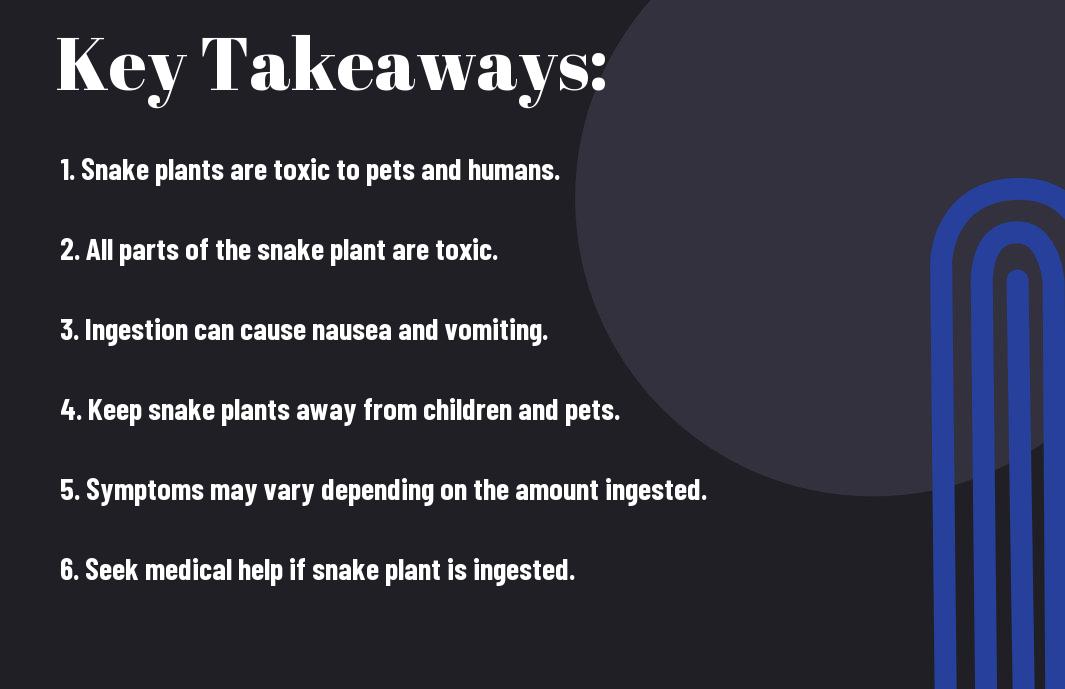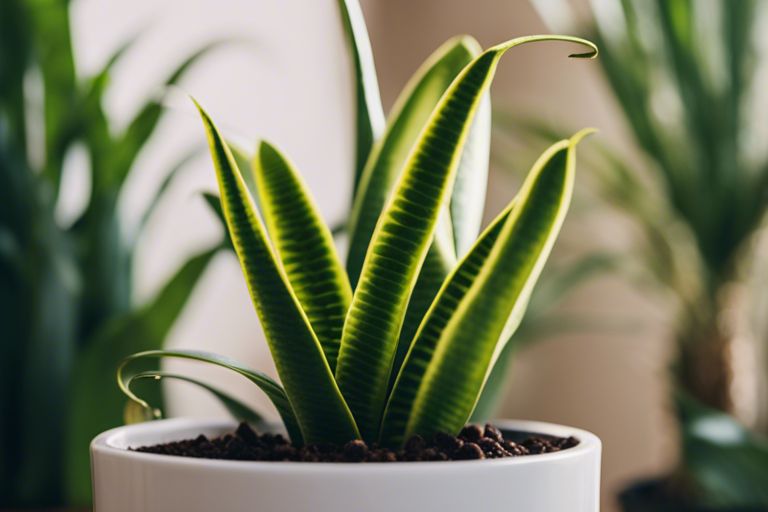You may have heard conflicting information about whether snake plants are toxic to pets or humans. In this detailed guide, we will debunk common myths and provide you with factual information about the toxicity of snake plants. Understanding the truth about these popular houseplants is important for keeping your loved ones safe.
One common myth is that snake plants attract snakes, which can be concerning for many individuals. To learn more about this myth and steps you can take to address it, check out our article Do Snake Plants Attract Snakes? [Truth With Steps To Take].
Key Takeaways:
- Snake plants are toxic to pets and humans: Contrary to common misconceptions, snake plants are indeed toxic when ingested by pets or humans. It is imperative to keep them out of reach of children and animals.
- Symptoms of snake plant poisoning: Symptoms of poisoning from snake plants may include nausea, vomiting, and diarrhea in pets and humans. Immediate medical attention is required if ingestion occurs.
- Precautions to take: To prevent accidental poisoning, place snake plants in areas where pets and children cannot access them. Educating family members about the toxicity of these plants is crucial to ensure everyone’s safety.

Understanding Plant Toxicity
Little is known about the actual toxicity of plants, especially when it comes to popular houseplants like the snake plant. Many misconceptions exist about their potential harm to humans and pets. To clarify these doubts, it’s crucial to understand the science behind plant toxicity.
Definition of Toxicity in Plants
One key aspect of plant toxicity is the presence of compounds that can cause harm if ingested or come into contact with the skin. Some plants contain toxins that can lead to mild reactions such as skin irritation or more severe symptoms like nausea, vomiting, or organ failure. The level of toxicity can vary among different plant species and even within the same genus.
How Toxicity is Measured in Plants
One common method to determine the toxicity of plants is through studies that assess the effects of plant parts or extracts on living organisms. These studies help researchers understand the potential risks associated with exposure to certain plants. Plant toxicity can also be evaluated by analyzing the concentration of specific toxic compounds present in the plant, which can vary depending on factors such as growing conditions and plant age.
On the other hand, some plants may not exhibit any noticeable toxicity despite containing potentially harmful substances. This can be due to the low concentration of toxins or the presence of compounds that counteract their effects. Understanding how toxicity is measured in plants can help differentiate between safe and potentially harmful species when choosing plants for indoor spaces.
The Snake Plant: Species and Characteristics
All across the globe, the snake plant is renowned for its resilience, air-purifying qualities, and unique aesthetical appeal. These qualities have made it a staple in many households, offices, and gardens. But what exactly makes the snake plant so fascinating? Let’s probe deeper into the taxonomy, species, and physical characteristics of this extraordinary plant.
Taxonomy and Species of Snake Plants
On the taxonomic front, the snake plant belongs to the genus Sansevieria, which is part of the Asparagaceae family. This genus encompasses around 70 different species, with the most popular being Sansevieria trifasciata. Commonly known as the mother-in-law’s tongue or viper’s bowstring hemp, this species is characterized by its long, upright leaves with striking patterns that resemble snakeskin.
Physical and Biological Traits
The snake plant is an intriguing mix of both physical and biological traits that contribute to its unique characteristics. Its leaves are thick and succulent, storing water to withstand times of drought. This attribute makes it an excellent choice for those who sometimes forget to water their plants. Additionally, it features a biological pathway known as crassulacean acid metabolism (CAM), allowing it to perform photosynthesis more efficiently, especially in arid conditions.
The snake plant also has the remarkable ability to purify the air by removing toxins such as formaldehyde, xylene, toluene, and nitrogen oxides. This makes it a perfect addition to indoor spaces, providing both beauty and functionality.
Common Myths Surrounding Snake Plants
Myth 1: Snake Plants Are Deadly
Despite common misconceptions, snake plants are not deadly. While they do contain toxins that can cause mild gastrointestinal discomfort if ingested, these plants are not lethal to humans or pets. In fact, snake plants are considered to be one of the best air-purifying plants and can thrive in indoor environments with minimal care.
Myth 2: No Pets Can Coexist with Snake Plants
One common myth surrounding snake plants is that no pets can coexist with them. However, this is not entirely true. While it’s recommended to keep certain pets away from snake plants to prevent potential ingestion, many pets can live safely alongside these plants. Cats and dogs, for example, are less likely to show interest in snake plants due to their texture and taste.
Plus, snake plants are not toxic to all pets. With proper placement and monitoring, many pet owners successfully keep snake plants in their homes without any issues.
Myth 3: All Parts of the Plant Are Equally Toxic
Pets may be curious and nibble on various parts of the snake plant, leading some to believe that all parts of the plant are equally toxic. However, the truth is that while the sap and leaves contain saponins which can cause mild irritation if ingested, the levels of toxicity are relatively low.
Myth 4: Snake Plants Emit Harmful Gases
Another common myth is that snake plants emit harmful gases at night, leading to respiratory issues. This misconception likely stems from confusion with the process of photosynthesis where plants take in carbon dioxide and release oxygen. However, snake plants are not known to emit harmful gases and are safe to keep in your bedroom for air purification benefits.

Scientific Facts About Snake Plant Toxicity
Known Toxins in Snake Plants
To address the question of whether snake plants are toxic, it’s important to understand the known toxins in these popular houseplants. Sansevieria trifasciata, commonly known as the snake plant, contains saponins, a type of chemical compound found in various plants. These saponins can be toxic to both humans and animals when ingested in large quantities. However, the levels of saponins in snake plants are typically low, making severe toxicity rare.
Clinical Symptoms of Poisoning in Humans and Animals
On the rare occasion that a human or pet ingests a significant amount of a snake plant, certain clinical symptoms may manifest. These symptoms can include gastrointestinal issues such as nausea, vomiting, and diarrhea. In more severe cases, individuals may experience symptoms like drooling, lethargy, and inappetence. It’s crucial to note that while these symptoms can be distressing, fatalities from snake plant toxicity are extremely rare.
Toxicity in pets like cats and dogs may present similarly to humans, with gastrointestinal upset being the most common symptom. It’s important to monitor pets closely if they have ingested any part of a snake plant and consult with a veterinarian if any concerning symptoms arise.
Safe Practices Around Snake Plants
After bringing a snake plant into your home, it’s crucial to be mindful of safe practices to prevent any potential harm. Handling and Placement of Snake Plants is a crucial aspect to consider to ensure the well-being of both humans and pets.
Handling and Placement of Snake Plants
Any direct contact with the sap or leaves of a snake plant can cause skin irritation in some individuals. It’s recommended to wear gloves when handling the plant to avoid any adverse reactions. Additionally, placing the snake plant in an area out of reach of children and pets is advised to prevent accidental ingestion, as ingestion can lead to symptoms such as nausea and vomiting.
First Aid Measures for Snake Plant Ingestion
After accidental ingestion of a snake plant, immediate action is crucial to minimize any potential health risks. Measures such as rinsing the mouth, drinking plenty of water, and monitoring for symptoms can help alleviate discomfort. If symptoms persist or worsen, seeking medical advice is recommended to ensure proper treatment.
Practices such as keeping the plant out of reach, educating household members about the potential risks, and being prepared with knowledge of first aid measures can help mitigate any incidents and promote a safe environment for everyone in the household.

Benefits and Uses of Snake Plants
Once again, we examine into the myriad benefits and uses of the popular snake plant. From air purification qualities to aesthetic and Feng Shui considerations, this versatile plant continues to charm plant enthusiasts around the world.
Air Purification Qualities
Uses: One of the most well-known benefits of snake plants is their exceptional ability to purify the air. These plants are adept at removing toxins such as formaldehyde, xylene, toluene, and nitrogen oxides, making them a valuable addition to any indoor space. This makes them not only visually appealing but also beneficial for your health.
Aesthetic and Feng Shui Considerations
Aesthetic: In addition to their air-purifying qualities, snake plants are lauded for their aesthetic appeal and Feng Shui benefits. Their striking vertical leaves add a touch of elegance to any room, making them a popular choice for interior decoration. In Feng Shui practices, snake plants are believed to bring positive energy and luck into the home, making them a must-have for those seeking harmony and balance in their living spaces.
Plants: When incorporating snake plants into your home decor, consider placing them in corners or areas with stagnant energy to promote flow and vitality. Their resilience and low-maintenance nature make them ideal for busy individuals or those new to plant care. By strategically placing snake plants in your home, you can enjoy their beauty while reaping the benefits of improved air quality and positive energy.
Debunking Myths: The Reality of Living with Snake Plants
Now, let’s examine into the realities of having snake plants in your living space. Despite the various misconceptions surrounding these striking houseplants, it’s imperative to separate fact from fiction to make informed decisions about introducing them into your home environment.
Addressing the Misconceptions
Addressing the misconceptions surrounding snake plants is crucial in understanding their true nature. One common myth is that snake plants are highly toxic to pets and humans. In reality, while snake plants contain toxins that can be harmful if ingested in large quantities, they are considered mildly toxic and typically only lead to minor symptoms when consumed.”
Real-Life Incidents and Experiences
With numerous snake plant owners sharing their experiences, it’s evident that living with these plants is generally safe. Many individuals have kept snake plants in their homes for years without any issues. Real-life incidents of toxicity are rare and usually involve pets or individuals with specific sensitivities. As with any houseplant, it’s imperative to practice caution and keep them out of reach of curious children and pets.
To reinforce safety measures, always wash your hands after handling snake plants and avoid ingesting any part of the plant. While some individuals may experience skin irritation or stomach discomfort if they come into contact with the sap, these reactions are generally mild and can be easily avoided by handling the plant with care.
Final Words
To wrap up, snake plants are indeed toxic to pets if ingested, as they contain harmful toxins that can cause symptoms such as vomiting and diarrhea. It is important for pet owners to be aware of this fact and take precautions to keep these plants out of reach of their furry friends. By debunking the myths and presenting the facts about snake plant toxicity, we hope to provide valuable information that can help keep pets safe and healthy in their home environment.
